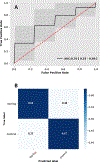Dynamic Intracranial Pressure Waveform Morphology Predicts Ventriculitis
- PMID: 34331206
- PMCID: PMC9847350
- DOI: 10.1007/s12028-021-01303-3
Dynamic Intracranial Pressure Waveform Morphology Predicts Ventriculitis
Abstract
Background: Intracranial pressure waveform morphology reflects compliance, which can be decreased by ventriculitis. We investigated whether morphologic analysis of intracranial pressure dynamics predicts the onset of ventriculitis.
Methods: Ventriculitis was defined as culture or Gram stain positive cerebrospinal fluid, warranting treatment. We developed a pipeline to automatically isolate segments of intracranial pressure waveforms from extraventricular catheters, extract dominant pulses, and obtain morphologically similar groupings. We used a previously validated clinician-supervised active learning paradigm to identify metaclusters of triphasic, single-peak, or artifactual peaks. Metacluster distributions were concatenated with temperature and routine blood laboratory values to create feature vectors. A L2-regularized logistic regression classifier was trained to distinguish patients with ventriculitis from matched controls, and the discriminative performance using area under receiver operating characteristic curve with bootstrapping cross-validation was reported.
Results: Fifty-eight patients were included for analysis. Twenty-seven patients with ventriculitis from two centers were identified. Thirty-one patients with catheters but without ventriculitis were selected as matched controls based on age, sex, and primary diagnosis. There were 1590 h of segmented data, including 396,130 dominant pulses in patients with ventriculitis and 557,435 pulses in patients without ventriculitis. There were significant differences in metacluster distribution comparing before culture-positivity versus during culture-positivity (p < 0.001) and after culture-positivity (p < 0.001). The classifier demonstrated good discrimination with median area under receiver operating characteristic 0.70 (interquartile range 0.55-0.80). There were 1.5 true alerts (ventriculitis detected) for every false alert.
Conclusions: Intracranial pressure waveform morphology analysis can classify ventriculitis without cerebrospinal fluid sampling.
Keywords: Clustering; External ventricular drainage; ICP waveform; Machine learning; Neurocritical care; Ventriculitis.
© 2021. Springer Science+Business Media, LLC, part of Springer Nature and Neurocritical Care Society.
Figures




Similar articles
-
Use of Clustering to Investigate Changes in Intracranial Pressure Waveform Morphology in Patients with Ventriculitis.Acta Neurochir Suppl. 2021;131:59-62. doi: 10.1007/978-3-030-59436-7_13. Acta Neurochir Suppl. 2021. PMID: 33839819 Free PMC article.
-
Neutrophil CD64 index in cerebrospinal fluid as a marker of bacterial ventriculitis in children with external ventricular drainage.BMC Pediatr. 2019 Apr 25;19(1):132. doi: 10.1186/s12887-019-1497-4. BMC Pediatr. 2019. PMID: 31023301 Free PMC article.
-
Significance of cerebrospinal fluid inflammatory markers for diagnosing external ventricular drain-associated ventriculitis in patients with severe traumatic brain injury.Neurosurg Focus. 2019 Nov 1;47(5):E15. doi: 10.3171/2019.8.FOCUS19407. Neurosurg Focus. 2019. PMID: 31675710
-
Ventriculitis associated with extraventricular drainage: etiology, diagnosis and treatment focused on neurocritic care units.Cir Cir. 2019;87(2):230-240. doi: 10.24875/CIRU.18000052. Cir Cir. 2019. PMID: 30768063 Review. English.
-
Factors and measures predicting external CSF drain-associated ventriculitis: A review and meta-analysis.Neurology. 2019 Nov 26;93(22):964-972. doi: 10.1212/WNL.0000000000008552. Epub 2019 Oct 28. Neurology. 2019. PMID: 31659095 Review.
Cited by
-
A preliminary study on the application of electrical impedance tomography based on cerebral perfusion monitoring to intracranial pressure changes.Front Neurosci. 2024 May 28;18:1390977. doi: 10.3389/fnins.2024.1390977. eCollection 2024. Front Neurosci. 2024. PMID: 38863884 Free PMC article.
-
Automatic identification of intracranial pressure waveform during external ventricular drainage clamping: segmentation via wavelet analysis.Physiol Meas. 2023 Jul 4;44(6):10.1088/1361-6579/acdf3b. doi: 10.1088/1361-6579/acdf3b. Physiol Meas. 2023. PMID: 37327793 Free PMC article.
-
A recurrent machine learning model predicts intracranial hypertension in neurointensive care patients.Brain. 2022 Aug 27;145(8):2910-2919. doi: 10.1093/brain/awab453. Brain. 2022. PMID: 35139181 Free PMC article.
-
Classification of intracranial pressure epochs using a novel machine learning framework.NPJ Digit Med. 2025 Apr 11;8(1):201. doi: 10.1038/s41746-025-01612-3. NPJ Digit Med. 2025. PMID: 40210973 Free PMC article.
-
Machine learning approach for noninvasive intracranial pressure estimation using pulsatile cranial expansion waveforms.NPJ Digit Med. 2025 Jan 26;8(1):57. doi: 10.1038/s41746-025-01463-y. NPJ Digit Med. 2025. PMID: 39865121 Free PMC article.
References
-
- Rosenbaum BP, Vadera S, Kelly ML, Kshettry VR, Weil RJ. Ventriculostomy: Frequency, length of stay and in-hospital mortality in the United States of America, 1988–2010. Journal of clinical neuroscience : official journal of the Neurosurgical Society of Australasia. Apr 2014;21(4):623–32. doi:10.1016/j.jocn.2013.09.001 - DOI - PubMed
Publication types
MeSH terms
Grants and funding
LinkOut - more resources
Full Text Sources

